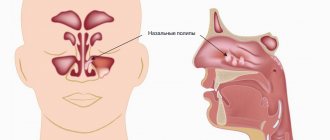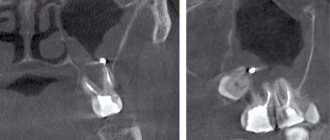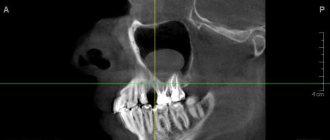Polyps in the throat have many manifestations; the most commonly diagnosed are benign neoplasms located on the tonsils and vocal cords. The period of polyp growth can last up to several years, so when they appear, you should contact a specialist to undergo diagnostics and determine treatment tactics.
When patients come to the Yusupov Hospital with any symptoms of this disease, the oncologist conducts an examination and prescribes diagnostic procedures to identify the shape, size and location of polyps. After examination, polyps in the throat are quickly and painlessly removed by surgeons.
Causes of development of polyps in the throat
Experts have identified many factors that provoke the development of polyps in the throat, but the causes of this disease have not been fully studied. Polyps on the throat ligaments, tonsils and larynx develop as a result of the following reasons:
- allergic reactions, the source of which cannot be eliminated;
- regular overstrain of the vocal cords when singing, shouting, whispering;
- drinking alcoholic beverages and coffee that irritate the mucous membrane;
- smoking;
- inhalation of heavy metal impurities during work;
- hereditary predisposition;
- dysfunction of the thyroid gland.
An oncologist at the Yusupov Hospital, when a patient comes in with this problem, conducts an examination and determines whether it is dangerous to leave a polyp in the throat unattended, and what methods are necessary to treat it.
Benign tumors of the oral cavity
Fibroids . Oral fibroids are most common in the lower lip, tongue, and palate. They look like a smooth oval or round formation, in some cases located on a stalk. The color of these oral cavity tumors does not differ from the color of the surrounding mucosa.
Fibromatosis of the gums . Not all authors classify gingival fibromatosis as a tumor of the oral cavity; some believe that it is based on inflammatory changes. Fibromatous growths are painless, dense formations. They can be local in nature within several teeth or diffuse, involving the entire alveolar process of both the lower and upper jaw. Tumor growths in fibromatosis are localized in the gum papillae and can be so pronounced that they completely cover the crowns of the teeth. This type of oral tumor requires differentiation from hyperplastic gingivitis.
Myomas . Develop from muscle tissue. Rhabdomyomas are formed from fibers of striated muscles. Most often they are observed in the form of single nodular formations in the thickness of the tongue. Leiomyomas develop from smooth muscle fibers and are usually located on the palate. Myoblastomas (Abrikosov tumor) are the result of disembryogenesis and are diagnosed in children under one year of age. They are a round tumor of the oral cavity up to 1 cm in size, covered with epithelium and having a shiny surface.
Myxomas . These oral tumors may have a round, papillary, or bumpy surface. They are located in the area of the hard palate or alveolar process.
Pyogenic granuloma
. Develops from the mucous or connective tissue elements of the oral cavity. Often observed after injury to the mucous membrane of the cheeks, lips or tongue. Pyogenic granuloma resembles richly supplied granulation tissue. It is characterized by a rapid increase in size up to 2 cm in diameter, dark red color and bleeding when touched.
Epulis . Benign tumors of the oral cavity located on the gums. They can grow from the deep layers of the gums, periosteum, and periodontal tissues. Epulis occurs most often in the area of the front teeth. They are classified into fibrous, giant cell and angiomatous formations.
Neuromas
. They are formed as a result of the proliferation of Schwann sheath cells of nerve fibers. They reach 1 cm in diameter. They have a capsule. Neuromas are practically the only tumors of the oral cavity that may be painful on palpation.
Polyps in the throat: photos and descriptions of tumors
Polyps in the throat, the symptoms of which depend on the size and location of the tumor, are formed by connective tissue, cellular elements and a small amount of fluid. Polyps are located in the throat on a thick stalk; they can have a white, pink or gray tint.
Some people who exhibit symptoms of this disease look at the laryngeal polyp in the photo and study the characteristic signs. Oncologists and otolaryngologists recommend not to carry out independent treatment of tumors, as it can cause chronic sore throat, infectious processes and irreversible changes in the voice.
The Yusupov Hospital uses modern methods for treating laryngeal polyps, which have successfully proven themselves in world medical practice. Highly qualified specialists remove the laryngeal polyp painlessly.
Causes of polyps in the mouth
The mechanism of formation of growths is due to intensive regeneration of epithelial cells in response to damage, irritation and other pathological influences. The tumor consists of muscle fibers, mucous epithelium, nerve and vascular trunks.
Risk factors may include various infectious lesions of the pharynx, dental procedures, long-term wearing of braces, and others.
The following factors and conditions can affect the formation of polypous lesions::
- Leukoplakia . The pathology is a precancerous condition, prone to the formation of carcinoma. Such polyps are accompanied by the formation of leukoplakic spots at the base.
- Cleanliness of the pharynx . Poor oral hygiene often leads to the development of inflammatory foci, periodontal disease, stomatitis and ulcerative lesions of the mucous membranes.
- Traumatic factors . Sharp edges of the teeth, abuse of alcohol and tobacco, aggressive solid foods, small cuts, burns - all this injures the mucous membranes of the pharynx, leading to the formation of bedsores on the edges of the tongue, new ulcerative-erosive lesions.
- Age-related changes . Various neoplasms in the oral cavity in people under 30 years of age are rare. Typically, pathological formations are observed in people over 50-55 years of age.
- Genetic predisposition . The appearance of polyps may be caused by certain genomic mutations that provoke various diseases of the mucous membranes of the pharynx, mouth and nasopharynx (for example, Fanconi anemia, congenital dyskeratosis).
- Chewing betel plant or tobacco . Betel nut in combination with tobacco causes serious damage to the mucous membranes and promotes the rapid transformation of polypous cells into atypical cancer cells.
- Human papillomavirus . The virus has up to hundreds of different subspecies. Only a few of them are characterized by intense cancer activity. The human papillomavirus often provokes the development of condylomas on the skin and polyps on the mucous membranes of internal organs.
Indirect factors in the formation of oral polyps are lichen squamous, implant rejection, decreased immune system of the body, and unbalanced diet.
Note ! Some clinical studies have proven the connection between the formation of polyps and constant rinsing with various solutions (strengthening rinses, for antiseptic dentures).
The formation of polypous neoplasms or malignant tumors is usually based on several factors.
Polyps in the throat: symptoms of the disease
Symptoms of polyps in the throat can be combined with manifestations of the underlying disease. Without exacerbation under the influence of negative factors, polyps do not appear in any way, so they may not be detected by patients for a long time.
With increasing polyps and frequent trauma, tears may occur, which worsen the patient's condition. A laryngeal polyp may have the following manifestations:
- pain when the vocal cords are tense;
- hoarseness of voice;
- feeling of a foreign summer;
- increased salivation;
- cough mixed with blood;
- pain syndrome in the neck area.
The Yusupov Hospital employs experienced oncologists who, when examining patients who complain, identify tumors in the throat. When visiting an oncology clinic, a patient can quickly and comfortably undergo an examination without queues at a convenient time by appointment.
Symptoms of nasal polyposis
In the early stages, the disease may occur without any noticeable symptoms.
Having arisen, the polyp gradually increases in size, filling the cavities available to it. If a polyp has formed in the paranasal sinus, you may not suspect it until it, having filled the sinus itself, penetrates through its outlet into the nasal cavity.
In advanced cases, polyps can descend from the nasal cavity and nasopharynx below, making it difficult to eat. The pressure of polyps on the walls of the sinuses can be very painful, and on the nasal septum - lead to its deformation.
Typical symptoms of nasal polyposis are:
Nasal congestion
Further growth of the polyp usually leads to difficulty breathing through the nose. Usually they complain of persistent nasal congestion; sometimes the polyp feels like a foreign body in the nose. Often the formation of polyps is accompanied by a decrease or complete loss of smell.
Runny nose
As always, when the nose does not breathe well, a runny nose develops, there is a decrease in hearing and, as a result, a lack of attention. Headaches, increased fatigue, and chronic fatigue are also possible.
More about the symptom
Nosebleeds
Mechanical impact on the polyp (for example, by sneezing or blowing your nose) can lead to damage (especially in the peduncle area), and then the polyp may begin to bleed. If there is periodic bleeding from the nose against the background of constantly difficult nasal breathing, then the cause is most likely a polyp.
Polyp in the throat: treatment
Modern specialists offer various ways to treat polyps in the throat. Drug therapy can improve the general condition of the patient, but it does not ensure the resorption of polyps. If a patient is found to have polyps in the throat, the symptoms and treatment of which depend on the size of the tumor, the oncologist at the Yusupov Hospital selects the most gentle and effective methods for eliminating them.
Polyps localized on the mucous membrane of the tonsils, vocal cords and larynx require surgical removal. For small polyps in the throat, minimally invasive techniques are used, allowing the patient to return to active life on the day of surgery.
If treated incorrectly, there is a high risk of relapse. To eliminate tumors in the throat, you should contact highly qualified specialists at the Oncology Clinic of the Yusupov Hospital, who will perform high-quality surgical removal of the polyp.
Treatment methods for nasal polyposis
Polyps that impede normal nasal breathing, as well as bleeding polyps, must be removed. There is no way that would make it possible to reduce the body of a polyp without resorting to surgery. Sometimes small polyps are not removed. But in this case, periodic monitoring of the condition of the polyp is necessary, since its growth can begin at any moment. It should also be remembered that polyps can degenerate into malignant tumors.
An important task is to prevent the re-formation of the polyp. In most cases, simply removing the body of the polyp is not enough. Since its formation is caused by a disruption of the normal functioning of the mucous membrane, it is necessary to establish the cause of this disturbance and eliminate it. Since polyps most often form against the background of allergic diseases, treatment of polyps should be combined with treatment of allergies. It is also important to help strengthen the overall immune system. Therefore, along with contacting an ENT specialist, you may need to consult an allergist-immunologist.
Drug treatment
Conservative (medicinal) treatment methods can be used to slow down the growth of the polyp, but such drugs cannot be used constantly.
Removal of polyps
Removal of nasal polyps in Moscow is possible in the Family Doctor network of clinics. For the treatment of polyps of the paranasal sinuses and nasal cavity, doctors at Family Doctor recommend using the Surgitron radiosurgical device. Removal of nasal polyps using Surgitron does not require hospitalization and can be performed in any of the Family Doctor clinics. If necessary, surgery to remove a polyp can be performed using a laser at a surgical hospital.
Make an appointment Do not self-medicate. Contact our specialists who will correctly diagnose and prescribe treatment.
Rate how useful the material was
thank you for rating
Removal of a polyp in the throat: price
The cost of surgical treatment of a polyp in the throat depends on the method of intervention, stage and other factors. The price of this service is determined after a comprehensive diagnosis in accordance with the current price list at the Yusupov Hospital. Each patient has the opportunity to receive complete information about the scope of treatment measures and their cost.
For patients diagnosed with throat polyps, oncologists develop an individual treatment plan. The key to high quality medical services provided to patients at the Yusupov Hospital is an integrated approach to solving this problem.
Treatment of stomach polyps
As stated earlier, all adenomatous and large polyps larger than 10 mm should be removed. How is endoscopic polypectomy or mucosal resection performed?
After clearly defining the boundaries of the formation, an injection of saline solution colored with indigo carmine blue dye is performed under its base into the submucosal layer in order to prevent perforation and clearly visualize the vascular structures. Then the endoscopic loop is positioned on the unchanged mucosa around the formation and is gradually tightened. Next, electrocoagulation is performed using an electrosurgical knife/block. A post-resection defect with a white scab without “plus tissue” indicates the radicality and reliability of the surgical intervention, thereby eliminating possible complications. The stages of the operation are presented in the pictures (in our Clinic we use a knife - ERBE VIO 300D).
Large exophytic (protruding) polyps on a wide base or flat formations that cannot be removed with endoloops are subjected to a technically more complex version of endoscopic removal - dissection in the submucosal layer. This type of operation is aimed at radical removal of the formation as a single block: after creating a “hydrostatic cushion”, a circular incision is made around the formation with special instruments, after which the connective tissue plexuses of the submucosal layer are dissected with complete elimination of the pathological focus.
Postoperative follow-up
The first day after polypectomy, a gentle regimen of activity and nutrition is recommended. As mentioned earlier, a post-resection defect of the mucous membrane remains at the site of the polyp, and therefore an anti-ulcer diet is prescribed - table No. 1 according to Pevzner. Its essence is to limit foods that stimulate secretion in the stomach, long-lasting and difficult to digest foods (spicy, fatty, fried foods). This diet and restriction of physical activity are followed for a month. It is also necessary to remember not to take anticoagulants for 3 days both before and after surgery, in order to prevent early and delayed bleeding.
According to modern concepts, the most rational is to monitor patients after polypectomy after 1 year. At the same time, the condition of the mucous membrane is assessed for the appearance of new formations or relapse at the site of a previously performed operation. If, after resection of the formations, the histological response confirms the presence of high-grade dysplasia or early cancer, then control gastroscopy should be carried out in the interval: 1.5 months - 3 months - 6 months. – 1 year and every year thereafter.
Localization
The location of polyps in the mouth area may vary. The tumor can be located on the inner surface of the cheeks and lips, in the sublingual area, or on the tongue.
Location on cheeks
Polyps on the cheeks can reach impressive sizes, interfere with the chewing process, and are constantly injured by teeth when grinding food. Such neoplasms often bleed, are prone to generalized spread, and are distinguished by a variety of forms and morphological structure.
Localization on the palate
When large polyps are located on the surface of the upper or lower palate, the swallowing process is disrupted and it becomes difficult to grind food when chewing. Often the pathological process tends to spread.
Any localization of polyps in the mouth is accompanied by serious risks:
- traumatization,
- bleeding,
- infections,
- association with various diseases of the mucous membranes.
Diagnostic measures
If you experience discomfort in the mouth area, you should conduct a self-examination. To do this, you will need to open your mouth wide, provide good lighting and examine the condition of the pharynx in the mirror. If necessary, you can use a small mirror to reflect hard-to-reach places (for example, the inner surface of the cheeks).
A professional examination is considered to be a dental examination using special instruments. The doctor will assess the condition of the oral cavity, exclude abscesses and cysts, especially if polypous lesions are localized in the gingiva.
In the absence of obvious dental problems, the patient is referred for consultation to a therapist and oncologist.
On examination:
- palpate regional lymph nodes,
- an ultrasound examination is prescribed,
- x-ray,
- MRI or CT diagnostics.
These methods make it possible to assess the degree of proliferation of the mucous membranes and determine the malignancy of the tumor at the earliest stages. An important examination is a biopsy of polypous lesions in the mouth and histological examination.
Among additional tests, it is necessary to collect urine, blood, and feces to exclude various diseases that could serve as a trigger for the formation of polyps. Often, eliminating the cause of the formation of polypous lesions promotes their independent “resorption.”
An important aspect in diagnosis is the study of the patient’s clinical and life history. If close relatives have oral cancer, a mandatory histological examination for cell atypia is required.










